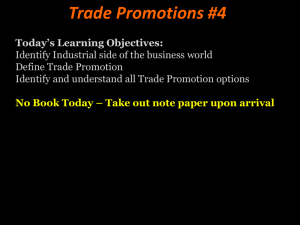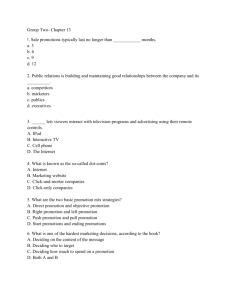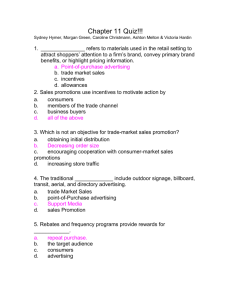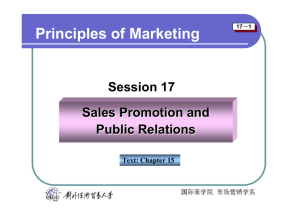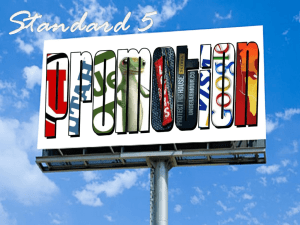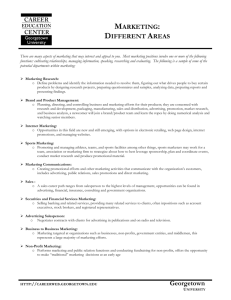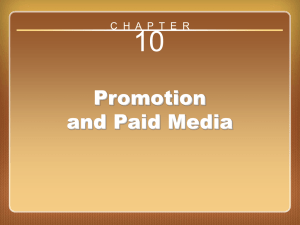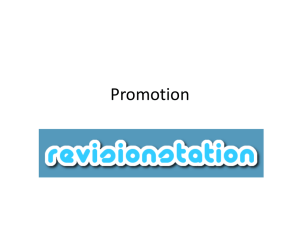chapter ??
advertisement
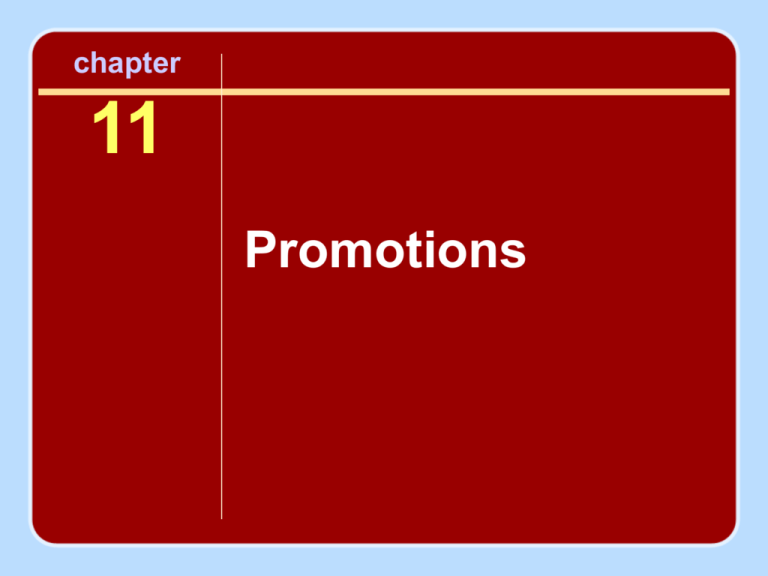
chapter 11 Promotions Objectives • To recognize the complexity of promotion with respect to the various forms it can assume as part of the marketing mix • To identify integral elements of promotion and the various approaches used in advertising • To understand promotion in a historical context and consider how that context has evolved as a result of the importance of media and sponsorship relationships • To recognize the key characteristics of effective promotional programs and campaigns aimed at expanding existing consumer bases and at increasing the frequency of consumption Promotions • Any activity designed to stimulate interest in, awareness of, and purchase of a product • Method to convey information about the place, price, and product • Critical in the positioning of a product in the mind of the consumer Types of Promotions • Advertising is any paid, nonpersonal (not directed to individuals), clearly sponsored message conveyed through the media. • Personal selling is any face-to-face presentation in which the seller has an opportunity to persuade the consumer. • Publicity is any form of exposure in the media not paid for by the beneficiary or within the beneficiary's control or influence. • Sales promotion involves a variety of activities including displays, trade shows, sampling, coupons, premium items, exhibitions, and performances. Goals of Promotions Promotions should include the following steps: • A: Increase awareness • I: Attract interest • D: Arouse desire • A: Initiate action Advertising Advertising should do the following: • Create awareness • Communicate information about attributes and benefits • Develop, change, and enhance an image • Associate brand or product with emotions • Precipitate behavior Keys to Effective Ad Campaign • Knowing the product • Knowing the consumers Batra, Myers, and Aaker Model of the Advertising Communication System • • • • • Source Message Channel Receiver Destination Assessing Effectiveness of Advertising • • • • Wasted circulation Cost per exposure Determining the creative approach Measurement (continued) Assessing Effectiveness of Advertising (continued) • Based on – Ability to reach target market – Ability to maximize cost per exposure – Appropriateness of creative message • Measuring – Impact on sales – Impact on image – Impact on consumer awareness Advertising Media For Sport • Signage • Endorsements and sponsorships • Print media – – – – – – – Magazine Newspaper Schedule cards Handouts and brochures Posters Information packages Direct mail • Electronic media – TV – Radio – Internet • Billboards, blimps, and buses Benefits of LED Signage • • • • • • • • • Higher resolution and clarity Movement Animation Sound Portability: Can be updated by simply programming; no hard production costs or delays Flexibility: Variety of sizes and shapes Real-time alterations Life cycle Increased inventory: No space Television Commercials: Structures • • • • • • • Story Problem solution Chronology Special effects Testimonial Satire Spokesperson • • • • • • Demonstration Suspense Slice-of-life Analogy Fantasy Personality Sales Promotions: Price • • • • Attract new consumers. Increase frequency of purchases. Reward loyalty. Prevent defection. Promotional Components • • • • • • • • • Theme Giveaways Product sampling Open house Coupons Bundling Contests and sweepstakes Premiums and redemptions Street promotions Game Promotions Game promotions should do either of the following: • Motivate customers to attend • Increase the perceived value of the event Those Who Do Not Attend the Games • • • • Aware nonconsumers Unaware nonconsumers Misinformed nonconsumers Media consumers Promotional Progression Planning Model • • • • Level 1: Nonpattern attenders (light users) Level 2: Multiple attenders (medium users) Level 3: Frequent attenders (heavy users) Level 4: Defectors (descending the escalator) Frequency Escalator Sales Promotions • • • • • • • • • Mailings Outbound calls: Telemarketing E-mail blasts Personal sales calls Hospitality Table Trade shows Retail outlet Kiosk Effective Use of Promotions • Promotions can increase perceived value at same price. Give them more! • Value is increased by using a giveaway: – Costs less than a price discount – Keeps price integrity – Draws customers from competitor
